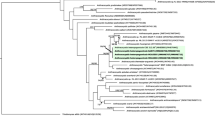Abstract
Five ascogenous, filamentous yeast species characterized by the formation of septal pore bodies and a primary association with ambrosia beetles, are transferred to the new genusAmbrosiozyma. A key to the species of the genusAmbrosiozyma is given.
Zusammenfassung
Fünf ascogene, mycelbildende Hefenarten, die durch die Bildung von septalen Porenkörperchen und eine primäre Association mit Ambrosia Käfern charakterisiert sind, wurden in die neue GattungAmbrosiozyma überführt.
Ein Bestimmungsschlüssel der Arten der Gattung wurde angegeben.
Similar content being viewed by others
References
Baker, J. M. (1963) Symposia of theSociety for General Microbiology XIII, Symbiotic Associations, pp.232–265.
Batra, L. R. (1963a) Ecology of ambrosia fungi and their dissemination by beetles.Trans. Kansas Acad. Sci. 66:213–236.
Batra, L. R. (1963b) Contribution to our knowledge of ambrosia fungi II.Endomycopsis fasciculata nom. nov. (Ascomycetes).Amer. J. Bot. 50:481–487.
Batra, L. R. (1967) Ambrosia fungi: a taxonomic revision and nutritional studies of some species.Mycologia 59:967–1017.
Batra, L. R. &Francke-Grosmann, H. (1964) Two new ambrosia fungi —Ascoidea asiatica andA. africana.Mycologia 56:632–636.
Beck, O. (1922) Eine neueEndomyces — Art,Endomyces bispora.Ann. Mycol. 20:219–227.
Besson, M. (1967) La fructification d'Ascocybe fragrans Wells (=Cephaloascus fragrans Hanawa) au microscope électronique.Extr. Bull. mens. Soc. linn. Lyon 36:230–233.
Besson, M. &Pignal, M. C. (1971) Personal communication.
Boedijn, K. B. (1960) On a new genus of the Endomycetaceae.Mycopath. Mycol. Appl. 12:163–167.
Boidin, J., Abadie, F. &Lehodey, Y. (1965) Le genrePichia sensu lato (Deuxième Contribution).Bull. Soc. Mycol. France 80:5–23.
Boidin, J., Pignal, M. C. &Besson, M. (1965) Le genrePichia sensu lato. (Quatrième Contribution).Bull. Soc. Mycol. France 81:566–606.
Fiol, J. B. (1967) Les besoins vitaminiques dans les genresDebaryomyces Kloecker Schwanniomyces Kloecker,Hansenula H. & P.Sydow etEndomycopsis Dekker.Compt. Rend. Acad. Sci. Paris, Sér. D, 264:1605–1607.
Francke-Grosmann, H. (1963) Some new aspects in forest entomology.Ann. Rev. Entomol. 8:415–438.
Graham, K. (1967) Fungal-insect mutualism in trees and timber.Ann. Rev. Entomol. 12:105–126.
Kreger-van Rij, N. J. W. (1970) The genusEndomycopsis inJ. Lodder (ed.) The Yeasts, 2nd Ed., pp.166–208, North Holland Publ. Co., Amsterdam.
Kreger-van Rij, N. J. W. &Veenhuis, M. (1967) Septal pores inEndomycopsis platypodis andEndomycopsis monospora.J. gen. Microbiol. 57:91–96.
Lodder, J. (1970) General classification of the yeasts inJ. Lodder (ed.) The Yeasts, 2nd Ed., pp.1–33, North Holland Publ. Co., Amsterdam.
Lodder, J. &Kreger-van Rij, N. J. W. (1952) The Yeasts, p.100, North Holland Publ. Co., Amsterdam.
Pignal, M. C. (1968) Quelques levures associées à des insectes xylophages de la République Centrafricaine.Cahiers de la Maboké 6:5–15.
Rudinsky, J. A. (1962) Ecology of Scolytidae.Ann. Rev. Entomol. 17:327–348.
Saito, K. (1932)J. Brewery Sci. 10:11 (in Japanese).
Schedl, K. E. (1958) Breeding habits of arboricole insects in Central Africa.Proc. 10th int. Congr. Ent. Montreal 1956 1:183–197.
Scott, D. B. &van der Walt, J. P. (1971)Pichia cicatricosa sp. n. a new auxiliary ambrosia fungus.Antonie van Leeuwenhoek J. Microbiol. Serol. 37:177–183.
Takada, H., Yagi, T. &Hiraoka, J. (1965) Elektronen-optische Untersuchungen anEndomycopsis fibuligera auf festen Nährböden.Protoplasma 59:494–505.
Van der Walt, J. P. &Scott, D. B. (1970) The Yeast genusSaccharomycopsis Schiönning.Mycopath. Mycol. Appl. 41:167–176.
Van der Walt, J. P. &Scott, D. B. (1971a)Saccharomycopsis synnaedendra, a new yeast from South African insect sources.Mycopath. Mycol. Appl. 44:101–106.
Van der Walt, J. P. &Scott, D. B. (1971b)Pichia ambrosiae sp. n., a new auxiliary ambrosia fungus.Antonie van Leeuwenhoek J. Microbiol. Serol. 37:15–20.
Verall, A. F. (1943) Fungi associated with certain ambrosia beetles.J. Agr. Res. 66:135–144.
Webb, S. (1945) Australian Ambrosia Fungi.Proc. Roy. Soc. Victoria, 57 (N.S.) Pts. I–II:57–79.
Wickerham, L. J. (1970) The genusHansenula inJ. Lodder [ed.] The Yeasts, 2nd Ed., pp.226–315, North Holland Publishing Co., Amsterdam,
Author information
Authors and Affiliations
Rights and permissions
About this article
Cite this article
van der Walt, J.P. The yeast genus Ambrosiozyma gen. nov. (ascomycetes). Mycopathologia et Mycologia Applicata 46, 305–315 (1972). https://doi.org/10.1007/BF02052126
Accepted:
Issue Date:
DOI: https://doi.org/10.1007/BF02052126




